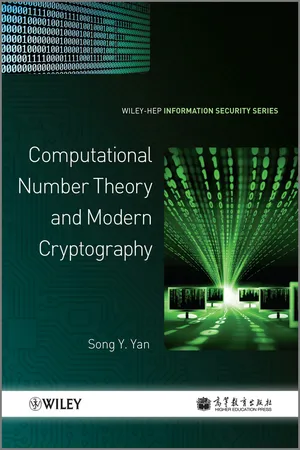
- English
- ePUB (mobile friendly)
- Available on iOS & Android
Computational Number Theory and Modern Cryptography
About this book
The only book to provide a unified view of the interplay between computational number theory and cryptography
Computational number theory and modern cryptography are two of the most important and fundamental research fields in information security. In this book, Song Y. Yang combines knowledge of these two critical fields, providing a unified view of the relationships between computational number theory and cryptography. The author takes an innovative approach, presenting mathematical ideas first, thereupon treating cryptography as an immediate application of the mathematical concepts. The book also presents topics from number theory, which are relevant for applications in public-key cryptography, as well as modern topics, such as coding and lattice based cryptography for post-quantum cryptography. The author further covers the current research and applications for common cryptographic algorithms, describing the mathematical problems behind these applications in a manner accessible to computer scientists and engineers.
- Makes mathematical problems accessible to computer scientists and engineers by showing their immediate application
- Presents topics from number theory relevant for public-key cryptography applications
- Covers modern topics such as coding and lattice based cryptography for post-quantum cryptography
- Starts with the basics, then goes into applications and areas of active research
- Geared at a global audience; classroom tested in North America, Europe, and Asia
- Incudes exercises in every chapter
- Instructor resources available on the book's Companion Website
Computational Number Theory and Modern Cryptography is ideal for graduate and advanced undergraduate students in computer science, communications engineering, cryptography and mathematics. Computer scientists, practicing cryptographers, and other professionals involved in various security schemes will also find this book to be a helpful reference.
Frequently asked questions
- Essential is ideal for learners and professionals who enjoy exploring a wide range of subjects. Access the Essential Library with 800,000+ trusted titles and best-sellers across business, personal growth, and the humanities. Includes unlimited reading time and Standard Read Aloud voice.
- Complete: Perfect for advanced learners and researchers needing full, unrestricted access. Unlock 1.4M+ books across hundreds of subjects, including academic and specialized titles. The Complete Plan also includes advanced features like Premium Read Aloud and Research Assistant.
Please note we cannot support devices running on iOS 13 and Android 7 or earlier. Learn more about using the app.
Information
Table of contents
- Cover
- Series
- Title Page
- Copyright
- About the Author
- Preface
- Acknowledgments
- Part 1: Preliminaries
- Part II: Computational Number Theory
- Part III: Modern Cryptography
- Part IV: Quantum Resistant Cryptography
- Index